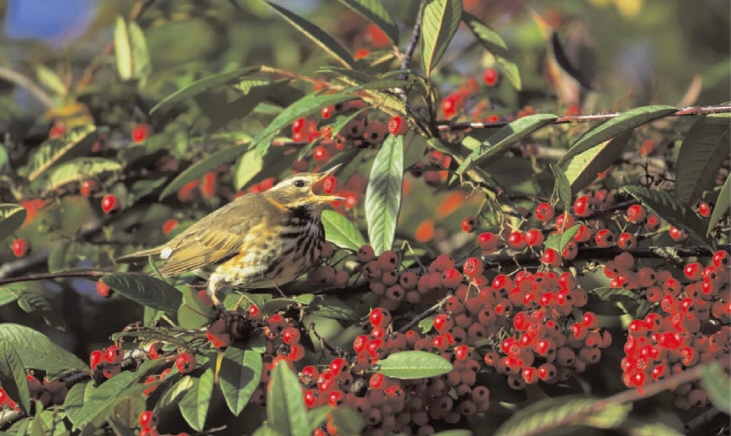
The urge to reproduce is a massive driving force for any bird, but the rather less exciting everyday needs for staying alive are equally important. Finding enough food and water to sustain itself through many seasons and conditions takes up most of a bird’s life.
This chapter is all about capturing birds going about their business, either feeding or drinking. It may seem a rather narrow subject to which to devote a whole chapter, but for the photographer the simple gathering of food can provide excellent opportunities not only to get up close to birds, but also to make some very interesting images.
Few photographers haven’t used bait to lure birds, even if this is only a peanut feeder in the garden. By providing regular food for birds, particularly in cold weather, we not only draw our subjects within camera range, but also help them to survive the bad times. This chapter would be rather dull if it centred around bird feeders, of course, but fortunately birds feed not only on a vast array of different foodstuffs, but also in a fascinating variety of ways, as you can see in the following pictures.

 REDWING
REDWING
(Turdus iliacus)
Canon EOS 1D Mark II, 500mm lens, 1/1,250th sec @ f4, digital ISO 400
Essex, UK
FLOWERS AND BERRIES
Autumn provides an abundant supply of food for birds as shrubs and trees set seed before the winter comes. Of all the goodies that are available at this time of year, it is the bright red and orange fruits of the berry bushes that are the most photogenic and attract my attention. The thrush family is particularly drawn to berry bushes, and several species of thrush tuck in to take advantage of the natural seasonal bounty. Exactly what species turn up and in what numbers depends not on our own climate, but on the climate far to the north of us in Scandinavia. In years when the berry harvest has been poor in these countries, or the weather has been particularly cold, vast numbers of thrushes head south, including Fieldfares and Redwings, species that don’t breed in the United Kingdom. It is in these conditions that it is best to head out with your camera and try your hand at the birds and berries pics.
In the case of the picture opposite, a fellow photographer kindly gave me the location, close to his home, where a number of Redwings were feeding in a popular country park. Several non-native berry-bearing bushes had been planted adjacent to the car park, and it was these that the Redwings were feeding on.
When photographing birds eating berries the backgrounds tend to be rather cluttered, but this is very difficult to avoid. Wherever possible I like to include as many berries as I can – it is their vibrant colours that add so much to the pictures and scream ‘autumn’. When the Redwings were feeding, I noticed that they would take a single berry in their bill, then flick it up into their mouth. This was the shot I wanted and I concentrated on trying to catch the moment, using the Canon EOS 1D Mark II due to its fast eight frames per second shooting capability.
There are some very specialized birds that feed only or mainly on flower nectar. This is a very high-energy food, but as you can imagine not the easiest of things to access. It is also very seasonal, and many of the species that specialize in feeding from flowers either live in the tropics or migrate to escape the non-flowering seasons. Flowers make fantastic subjects for the photographer on their own, of course, but add a colourful exotic bird as well and you can’t go wrong.
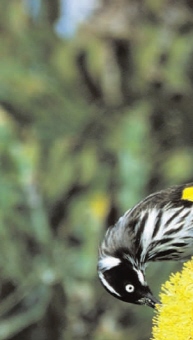
 NEW HOLLAND
NEW HOLLAND
HONEYEATER
(Phylidonyris novaehollandiae)
Canon EOS 1V, 500mm lens + 1.4x converter, tripod, exposure unrecorded, Fuji Provia 100
Western Australia
It was flowers, in fact, that we’d travelled to photograph in the south of Western Australia at the end of winter. The winter rains had been particularly good that year, and the flower bloom responded with a fantastic display from an array of species, often in huge drifts. It was not only the groundcover plants that were blooming – the Banksia trees were also in full bloom, with huge bright flower spikes reaching up to the sky.
On a visit to the wonderfully named Two Peoples Nature Reserve, we came across a small example of this yellow-flowered Banksia growing not too far from the trail. There seemed to be a regular procession of New Holland Honeyeaters coming to feed on the flowers, so I set up my camera on a tripod and simply waited. I was using a long lens and was far enough away from the flowers so as not to disturb the birds, and they quickly obliged and posed on the blooms in front of us.
The birds were feeding from several flowers, but I chose the particular one featured in the photograph because I liked the composition of the two flowers together. The birds ignored the flower to the right because it had not yet fully opened. Needless to say, for a while the birds seemed to land on all the flowers except the one I wanted, but they would not have made such a nice image as ‘my’ flower, so I stuck to my guns and eventually got the shot I wanted.
THE FISHERMEN
In Britain we are blessed with huge seabird colonies around our coasts, and not surprisingly fish form the bulk of their diets. Unfortunately, humans are doing all they can to destroy the fish stocks and pollute the oceans, so the seabird colonies may soon become a thing of the past. This would be a great tragedy, and the world would seem a less wonderful place without the teeming seabird cities.
It is only during the breeding season that the colonies are filled with birds, and this is undoubtably the best time to visit, with mid- to late June probably being the most productive. Although there are exceptions, it is offshore islands that harbour most of the colonies. Birds that spend most of their lives out at sea can be remarkably tame on land, showing little fear of humans. Despite their apparent indifference to us, you should show respect for them and always move slowly and carefully so as not to scare them.
It was on a visit to the Farne Islands that I took this classic picture of a Puffin with a mouthful of sand eels. I’d been to the Farnes many times and (as always) was looking for something a bit different from the many portraits I had already taken, some with fish and some without. Every visit is different, and on this occasion the Puffins seemed particularly confiding and would stand around near the jetty just a metre or so away from the path. Puffins are renowned for being able to fit a relatively large number of sand eels in their bill at one time, and it was this aspect of the birds’ behaviour that I wanted to capture. After several attempts I came up with the picture you see opposite.
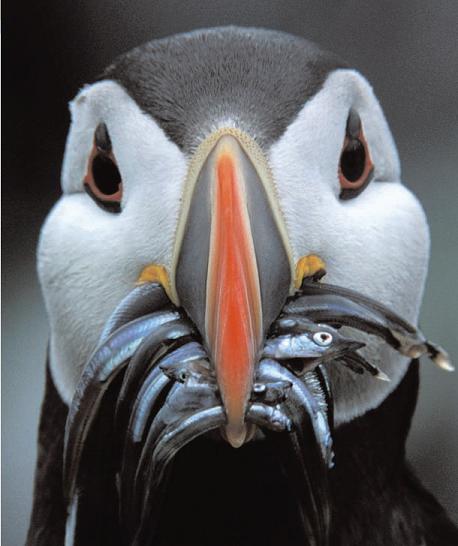
 PUFFIN
PUFFIN
(Fratercula arctica)
Canon EOS 1V, 600mm lens + 2x converter, tripod, around 1/15th sec @ f32, Fuji Provia 100
Farne Islands, UK
Despite its seeming simplicity, this was not an easy picture to take and this was way back in the days of film, when you couldn’t check your results until a week or so later. I fitted a 2x converter to the huge 600mm lens, giving me an effective focal length of 1,200mm. This enabled me to concentrate on just the head of the Puffin in the frame. At such ridiculously long focal lengths at such close range, depth of field was almost non-existent, and to try and get most of the Puffin’s bill and sand eels in focus I stopped down to an effective f32. This meant shooting at a mere 1/15th of a second at 24x magnification, so keeping the whole set-up steady and avoiding camera shake was a bit of a challenge. I took quite a few pictures to increase my chances of success. It was with some relief that I found a couple of sharp slides among the many affected by camera shake when the slides finally returned from the processor.
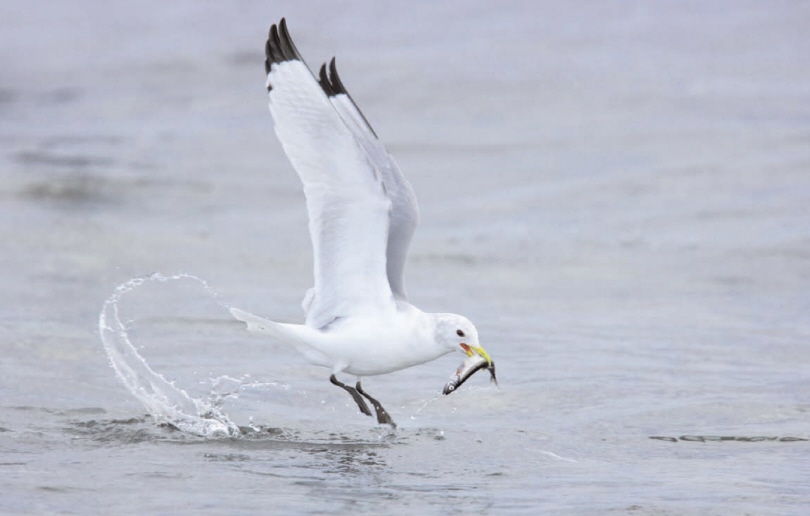
 KITTIWAKE
KITTIWAKE
(Rissa tridactyla)
Canon EOS 1Ds Mark II, 400mm lens + 1.4x converter, hand-held, 1/800th sec @ f5.6, digital ISO 400
Norway
The second picture in this section (shown opposite) could not be more different from the first. Although it still depicts a seabird with fish, it is all action. The other difference is that, unusually for such pictures, this one was taken in winter rather than during the breeding season. The contrast between these two images goes to demonstrate the variety of pictures that can be created on just a single topic such as birds with fish.
I was well north of the Arctic Circle when I took this picture at Varanger Fjord at the top of Norway, and there was still snow on the ground in March. I certainly hadn’t expected to see Kittiwakes here at this time of year – I usually associate them with the breeding colonies in the summer months. There were many thousands of them to be found all around this remote coast, though, bobbing around on the ever-present wind. This particular shot is not exactly as it seems, however, because the Kittiwake is not catching a live fish from the water, but picking up a dead one. Mysteriously, we found hundreds of dead small fish all along the shore of one particular stretch of Varanger Fjord. There was a long line of them along the high-tide mark, but the large flock of Kittiwakes was not taking these, but plucking others from the shallow water just off the beach. Kittiwakes are great scavengers and will follow fishing vessels for scraps thrown overboard, so these dead fish were a real bonus for them.
The key for me to the success of this image is twofold. Firstly, the position of the Kittiwake’s wings at the very top of the wing beat adds height to the picture, and in this position the wings are not in the way of anything else. The second thing is the water just behind the bird. The ‘hole’ left in the water where the Kittiwake briefly broke the surface is clearly visible, and that marvellous semicircular trail of water lifted into the air by the bird clinches it for me.
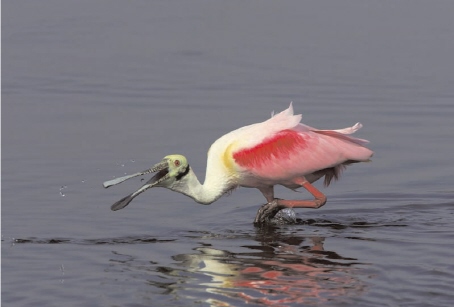
 ROSEATE SPOONBILL
ROSEATE SPOONBILL
(Ajaia ajaja)
Canon EOS 1D Mark II, 500mm lens + 1.4x converter, tripod, 1/1,000th sec @ f10, digital ISO 200
Florida, USA
THE STROLLERS
So far we have seen some of the different types of food that birds eat, but the various methods that they use to acquire that food are often fascinating and therefore of great interest to the bird photographer. One very common method for birds that feed mostly in shallow water involves simply walking about slowly and snapping up anything that they come across, often using their bill to probe and feel for small fish and other diminutive creatures that inhabit the marshes.
This type of behaviour is relatively easy to photograph – although they are moving, the birds’ rather sedate pace makes them easy targets. These ‘strollers’ are usually quite large waterbirds with relatively long legs to enable them to wade through the water. Among such species is the beautifully plumaged Roseate Spoonbill (above), which is found in the Americas. One of the easiest places to photograph this bird is Florida, which is where I took the picture. While driving through Merrit Island National Wildlife Refuge, we had stopped to photograph some herons in a large lake when a flock of a dozen or so Roseate Spoonbills flew in. As was usual in Florida I was simply standing by the side of the lake with my camera gear on a tripod in full view of the birds, which were ignoring me. Only a couple of the birds were in full breeding plumage, and it was one of these that I concentrated on, ignoring the paler plumaged birds completely. Knowing exactly what you want and sticking to it is the best way to ensure success.
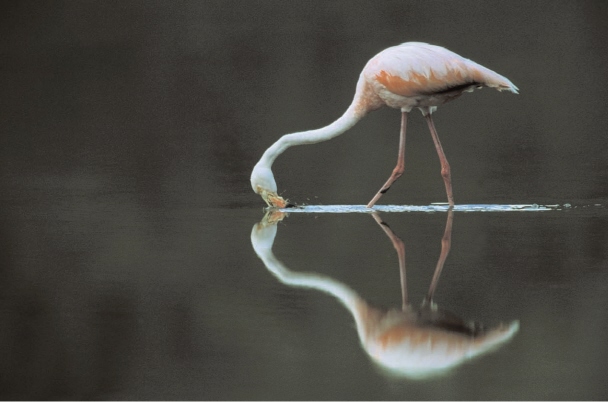
 GREATER FLAMINGO
GREATER FLAMINGO
(Phoenicopterus ruber)
Canon EOS 1V, 500mm f4 lens + 1.4x converter, tripod, approx. 1/60th sec @ f5.6, Fuji Provia 100.
Galapagos Islands
While watching the bird I noticed that it used its bill to locate its prey under the surface of the water, then threw it up in the air and caught it. The problem was that this all happened so fast that I couldn’t see what it was catching. It was only later, when I was able to blow up the digital image, that I could make out the shape of a small fish perfectly caught in mid-air between the upper and lower bill plates, heading for the throat. Capturing that precise moment of behaviour that you would never otherwise be able to see, let alone examine in detail, is one of the great pleasures of photographing birds in action.
Although many of the larger waterbirds ‘stroll’ through the water in a similar way, they don’t all feed on the same type of food or even feed in the same way. The flamingos have a pretty unique method of feeding – they lower their neck and tilt their head so that their large, curved bill is actually upside down in the water and facing back towards their legs. They then move their head from side to side while walking slowly forwards. Using a specially developed structure within the bill to trap any food particles, they then use their tongue as a simple piston to suck the water through. Aquatic insects are the main food, although very small fish fry may also be taken.
I took the picture opposite on the Galapagos Islands. After arriving early one morning on Floreana Island on a dull, overcast day, we located a small group of flamingos quietly feeding in the bottom of a caldera filled with shallow water. The still conditions created nice reflections in the water, but it was quite dark so photography was not straightforward. Fortunately the birds were slow-moving, the fastest bits being their heads as they swung back and forth through the dark green water. With a shutter speed of only 1/60th of a second, I used the image stabilization feature on my big telephoto lens to minimize camera shake, and took a few rolls of film to make sure that I had stopped the head movement in at least a few of the shots.
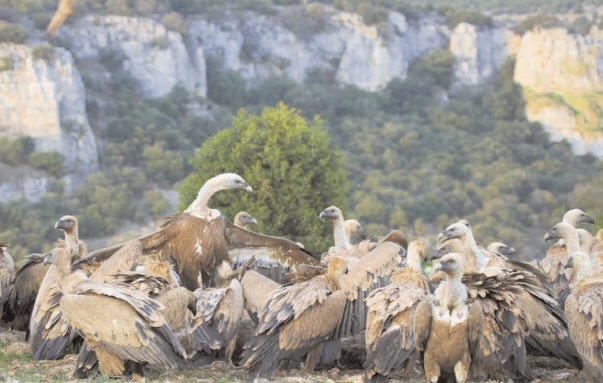
 GRIFFON VULTURES
GRIFFON VULTURES
(Gyps fulvus)
Canon EOS 1Ds Mark II, 100–400mm lens @ 130mm, tripod, 1/100th sec @ f5.6, digital ISO 400
Spain
THE REFUSE COLLECTORS
To us humans, probably the least attractive form of feeding is carried out by the bird species that eat dead animals – the carrion feeders. Of course, such birds fulfil a vital role and quickly devour a carcass that would otherwise be left rotting for days or weeks, with the increased possibility of spreading disease to other wildlife. The most famous carrion eaters are, of course, the vultures, many of which are (to our eyes) unattractive birds. Vultures tend to have bare heads and necks that enable them to feed deep inside a bloody carcass without the inconvenience of matting longer feathers that would be almost impossible to clean. This adaptation to their feeding habits gives them a rather reptilian appearance, which does little to endear them to us. Their manners also leave a lot to be desired, as they kick and fight with their fellow diners to grab as much meat as quickly as they can.
I had been sitting in a small hide in the mountains north of Madrid since before dawn. In front of the hide was a dead sheep that had been put out specifically for the vultures at a feeding station, or ‘vulture restaurant’, as they are sometimes called. The location was on the edge of a cliff overlooking a valley far below, and as the sun rose the first vultures started to gather, although they remained some distance from the carcass. Suddenly, without any warning, one vulture swooped down and landed next to the dead sheep. This was the signal, and within seconds the carcass was completely covered with dozens of Griffon Vultures. A fully grown adult sheep lasted no more than 15 minutes, after which all that could be seen were a few bones and the odd bit of wool. A primeval scene had come to an end and the vultures left.
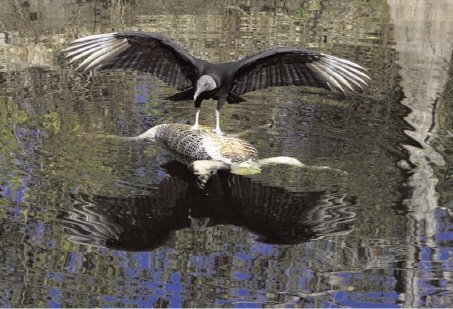
AMERICAN BLACK VULTURE
(Coragyps atratus)
Canon EOS 1D Mark II, 100–400mm lens @ 160mm, hand-held, 1/1,000th sec @ f7.1, digital ISO 200
Florida, USA
It is very difficult to photograph a scene like this because you are faced with a rugby scrum of birds, most of them face down and the nearest ones inevitably with their backs to you as the feeding mob surrounds the carcass. It was also very early in the morning so there wasn’t much light available, which didn’t help as the depth of field would have to be at a minimum. In the image I have used the spread wings of a newly arrived vulture that had landed on top of the scrum and was trying to force its way in. Notice its raised foot and spread-out toes as it pushes towards the carcass with its neck craning forwards. The picture was also carefully framed so that the vultures were in the bottom half of the image, allowing enough space to also show the white cliffs on the other side of the valley, which put the scene in its environment.
Not all vultures feed in such a frenzy, although American Black Vultures do congregate in reasonable flocks if the size of the carcass allows. This was clearly not the case with the floating dead alligator (shown on the left), which would only really hold a single bird at a time.
I was driving along the Tamiami Trail in southern Florida when I noticed a group of Black Vultures sitting around in the trees by the side of the road. I stopped the car and went over to investigate. A canal runs the entire length of the road, its edges for the most part covered by large cypress trees. It’s a very good place to find alligators, and we had seen several live ones already. I found that the vultures had congregated around a dead alligator in the water. As I arrived at the scene a vulture flew up from the carcass to join the others in the trees, but within a few minutes it returned and landed once again on the dead alligator. The carcass was lying in water, and it moved as the large, heavy bird landed on it and put out its wings for balance. That was the moment when I took the picture – you can see the ripples from this movement in the water.
The reflection of the blue sky and cypress wood, as well as the vulture itself, make this a rather unusual picture of a carrion feeder at work. The dappled shade caused by the surrounding trees made it technically difficult to execute – it would have been impossible on film. I had to underexpose most of the image so as not to burn out the sunlit highlights, then balance the picture in post processing using curves.
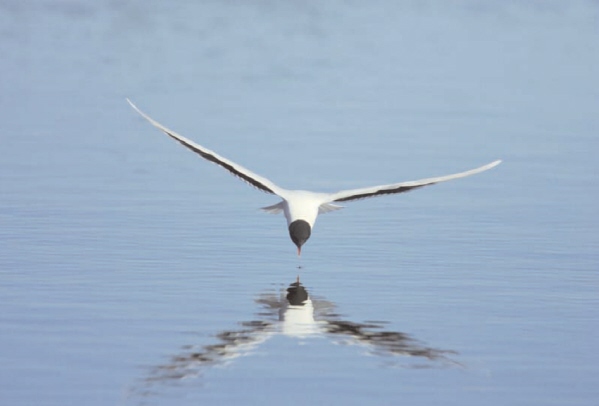
 LITTLE GULL
LITTLE GULL
(Hydrocoloeus minutus)
Canon EOS 1D Mark II, 400mm f4 lens + 1.4x converter, hand-held, 1/2,500th sec @ f5.6, digital ISO 400
Hailuoto Island, Finland
THE FLYING PLUCKERS
There are some birds that use amazing aerobatic skills to catch their prey. This section deals with those that pluck their food out of the water. These species can provide opportunities for some truly spectacular pictures – full of action as the bird swoops down over the water to claim its prize. By their very nature, however, scenes like this are among the most difficult of subjects to photograph.
My wife and I were on Hailuoto Island in Finland, where we came across a colony of Little Gulls by a bridge that crossed a large lake. The colony itself was some distance away and inaccessible due to the terrain, but many of the gulls were zipping over the water quite close to the bridge, chasing the numerous flies that were on the lake’s surface.
Little Gulls are surely one of the most acrobatic of all the gulls, and these were constantly changing direction and swooping down to the surface in an instant, giving no warning as they did so. My only chance was to choose a gull and try to follow it as it flew around and (hopefully) went down to chase a fly.
The shot was one of my favourites. It shows a gull with its bill open, about to pluck a fly from the surface. The reflection adds to the image, but a fraction of a second later and it would have spoiled the picture because the fly would have been lost. As it is the fly is perfectly positioned between the bill and its reflection. Did I see all of this at the time? Of course not, but I took a lot of pictures that day and finally got the one I wanted.
Small, agile fliers like the Little Gull are perhaps the obvious candidates for this type of acrobatic feeding. Herons and egrets are not species that you would normally associate with impressive flying skills – they are usually seen flapping along rather sedately overhead. The Snowy Egret, however, has developed a method of fishing that is known as ‘dip-feeding’, something that is also practised by the similarly sized Tricoloured Heron. Quite how the birds achieve this I really don’t know. They fly very slowly over the water, sometimes trailing their feet just on the surface. Suddenly they seem to almost halt in mid-air and pluck out a small fish that is just below the surface of the water. They then continue to the shallows or dry land, where they devour their prey. Once again, this is a little tricky to photograph because it is over very quickly indeed.
We had just entered the wildlife drive in Merritt island National Wildlife Refuge, near to where they launch the space shuttle, when a small pond caught my eye. It wasn’t very attractive, but there was a large number of Snowy Egrets sitting around the edge. The pond was right next to the road and a large telephoto lens was just too much, so I set up and hand-held my 100–400mm zoom. It was quite a dull day, but because the birds were white I could still use a fast shutter speed.
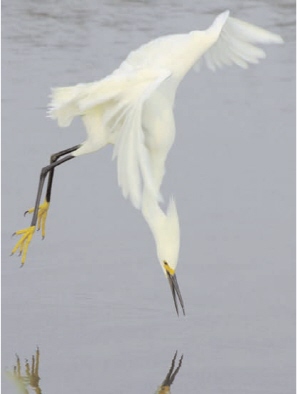
 SNOWY EGRET
SNOWY EGRET
(Egretta thula)
Canon EOS 1D Mark II, 100–400mm zoom lens @ 310mm, hand-held, 1/1,000th sec @ f5.6, digital ISO 200
Florida, USA
The above shot shows a Snowy Egret apparently hovering over the pond. In fact, it still has forwards momentum, otherwise it would have fallen into the water. Its legs at this moment were moving faster than its head, which sort of stretched back towards the water in order to try and catch a fish. A moment after I took this picture the bird dipped its head into the water, but failed to catch a fish. It then continued its flight over the pond to land once again on the edge. The bird may have failed to make a catch, but I hadn’t and produced one of my favourite images from our two-month trip to Florida.
PLUNGE DIVERS
Surely the most spectacular feeders are the plunge divers, the birds that hurl themselves head-first into the water at great speed so that they have enough momentum to travel deep under the water in search of fish. In order to do so, they must avoid smashing their wings to pieces as they hit the water at speed. They do this by swinging their wings behind them at the last second to make themselves much more streamlined as they make contact with the water. Needless to say, such actions make great subjects for the bird photographer.
We were on Sanibel Island, and in the afternoon had visited the fishing pier where Snowy Egrets would gather to steal fish from the people that gave the pier its utilitarian name. A couple of immature Brown Pelicans had also put in an appearance, but it was when I noticed some adults a little further up the coast that I wandered off to see if I could get some action shots. A big lens certainly wasn’t necessary for the extremely tame Snowy Egrets, so all I was carrying was my very useful 100–400mm lens. When the pelicans stared to plunge-dive right in front of me I couldn’t quite believe my luck and started shooting. One of my favourite pictures is shown. It features not just one bird, but two, hurtling towards the ocean head first.
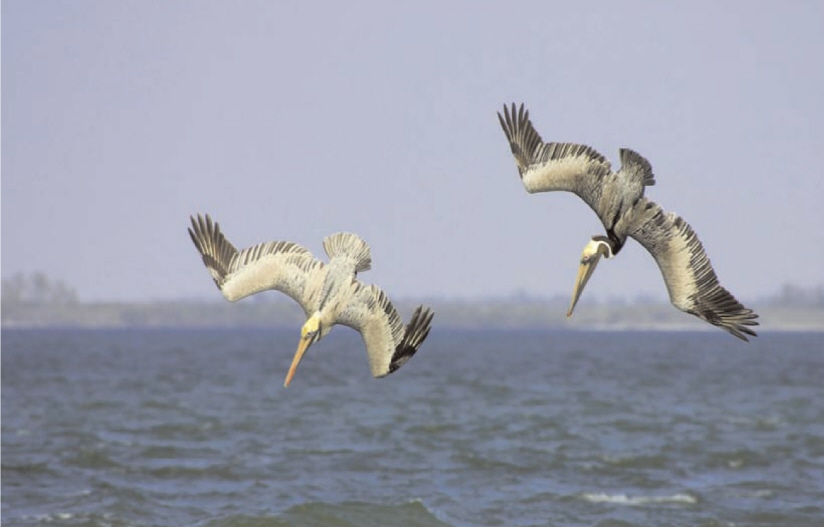
 BROWN PELICANS
BROWN PELICANS
(Pelecanus occidentalis)
Canon EOS 1D Mark II, 100–400mm lens @ 400mm, hand-held, 1/1,000th sec @ f8, digital ISO 200
Florida, USA
Photographing two birds diving in tandem like this is nigh on impossible due to the very limited depth of field available when using telephoto lenses. It worked in this case because both birds were exactly the same distance from the camera when they dived, and therefore both were in focus. The other thing to notice about this shot is that the horizon is dead straight. In the original it was just a little out, but with digital post processing you can always end up with a perfect horizon.
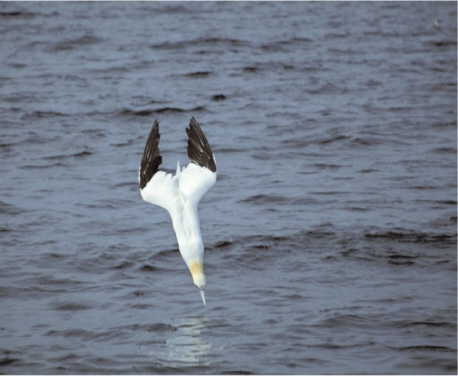
 GANNET
GANNET
(Morus bassanus)
Canon EOS 1V, 300mm f2.8 lens, hand-held, approx 1/2,000th sec @ f4, Fuji Provia 100
North Sea
The Brown Pelicans in Florida are one of the easiest diving birds to photograph due to their large size and relatively slow and telegraphed movements. At the other end of the scale is the Gannet, a true master of the art. These amazing birds can dive from nearly 30 metres above the sea and hit the water at up to 100 kilometres per hour. It is estimated that the momentum of the dive takes them as far as 3.5 metres below the surface, although they can then swim down to a depth of around 15 metres.
The picture on the left shows a Gannet just a few centimetres above the sea, with its wings sweeping back ready for impact. In the split second remaining before the bird actually enters the sea, the wings are thrown back even further to avoid them being broken by the force of the dive.
This has to be the most difficult subject I have ever photographed. I was on a small boat that was bobbing around in the swell. I was trying desperately not only to lock onto the fast-moving Gannets, but also to stay upright myself. I used a lot of film that day and had quite a high failure rate, but finally got a few shots that made it all worthwhile. I must try and find an opportunity to do this again now with digital and the fast-shooting cameras that are now available.
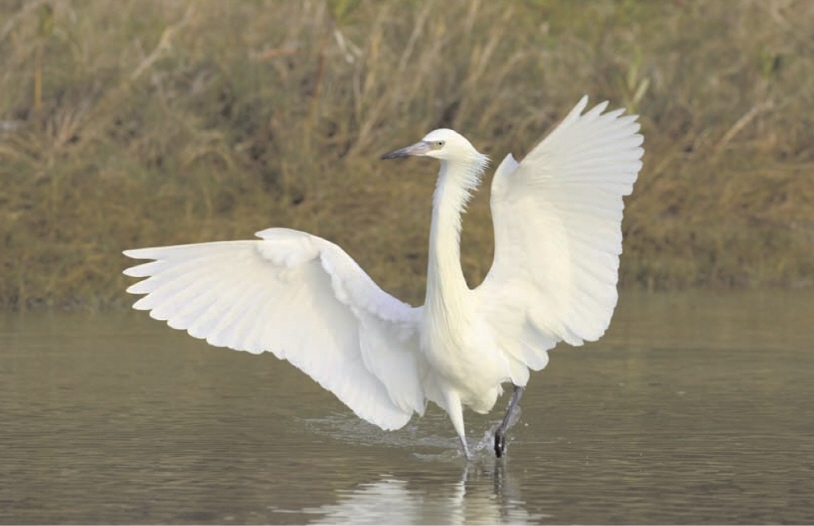
 REDDISH EGRET
REDDISH EGRET
(Egretta rufescens)
Canon EOS 1D Mark II, 500mm lens, tripod, 1/1,000th sec @ f7.1, digital ISO 200
Florida, USA
SIMPLY CRAZY
The Reddish Egret has a truly individual method of feeding that is like no other bird’s I have ever encountered, and thus deserves a category all of its own. When searching for food these birds make me laugh out loud as they rush across the shallow lagoon, changing direction frequently and sometimes jumping up and down to add to the show, their bristling feathers making them look like classic cartoon ‘mad professors’. The apparently erratic behaviour is designed to confuse the fish and take them by surprise. This is a truly wonderful bird and one of my all-time favourites. Looking at the image above you may wonder why this species is called the ‘Reddish Egret’, but this is in fact the relatively rare ‘white morph’ – the normal colour form of the bird is a dull reddish-brown, hence the name. This particular individual was photographed quite late on a bright, overcast day in a small lagoon at Fort de Soto, a park close to the Florida city of St Petersberg. Bright overcast is the perfect condition for white birds as long as you are not photographing them against the sky, when you really need the sky to be blue. Direct sunlight makes the contrast of the white bird against the darker background very high, and you have to underexpose the surroundings to ensure that the bird itself is not overexposed. The lack of direct sunlight also results in considerably softer and less intrusive shadows.
As is usual in Florida, we were simply able to stand by the side of the lagoon as the bird danced up and down in front of us until it eventually caught a fish. Clearly this apparently crazy approach to fishing works.
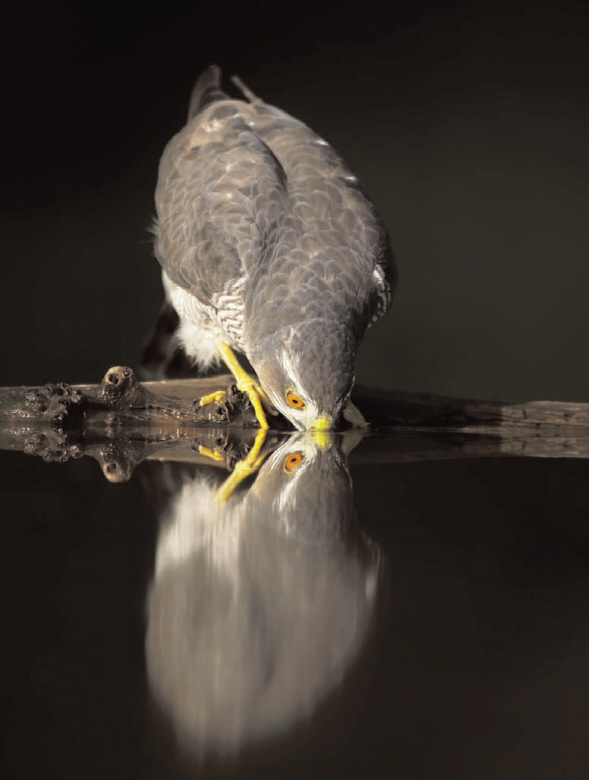
 NORTHERN GOSHAWK
NORTHERN GOSHAWK
(Accipiter gentilis)
Canon EOS 1Ds Mark II, 500mm lens, tripod, 1/1,000th sec @ f4, digital ISO 400
Hungary
DRINKING
Although this chapter is entitled food and drink, it is the food aspect that produces the most varied images, because the feeding habits of birds are so diverse. This is not the case when it comes to drinking, however, because most birds tend to drink in the same, rather unexciting way.
Despite this, I don’t think that anyone would consider this picture of a male Northern Goshawk drinking at a forest pool unexciting. Certainly there was some tension in the air when I was photographing this marvellous bird, slowly sipping water just a few metres in front of me. I spent a whole week sitting in hides that had been set up by specially constructed drinking pools, which the birds had got very used to, and quite a variety of species was coming down to drink and wash. I was contentedly photographing finches, thrushes and other small birds, when in an instant they all disappeared, leaving the drinking pool deserted.
Some time passed before all of a sudden this male Northern Goshawk landed by the side of the pool. Given that he was pretty much at the top of the local food chain he seemed remarkably nervous, and simply stood motionless for much of the time, occasionally looking around him. I too was motionless and stayed completely still, not daring to even take a picture in case the sound of the shutter frightened off the bird. The temptation to blast away was almost overwhelming, but I managed to resist until finally he settled down on a log next to the pool and started to drink. Now that the bird was relaxed I started to take pictures, not firing off a great sequence, just a couple at a time so as not to disturb him. He stayed for a wonderful few minutes until he had had his fill, finally flying off into the surrounding forest. This was a truly magical moment and one I shall never forget.